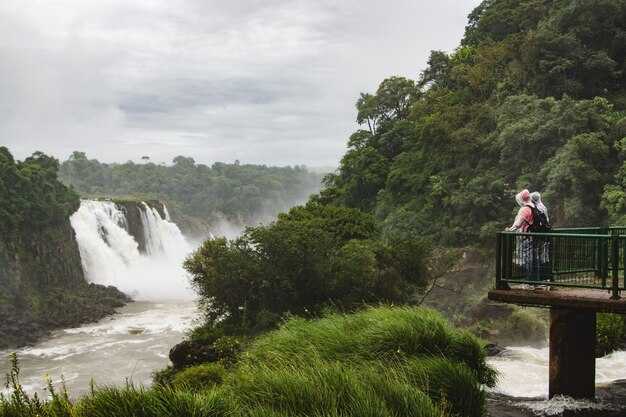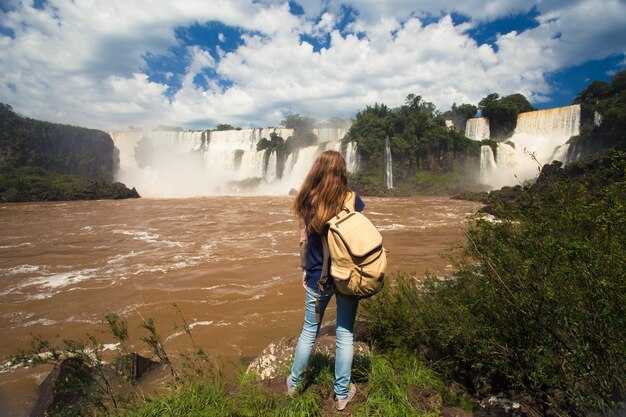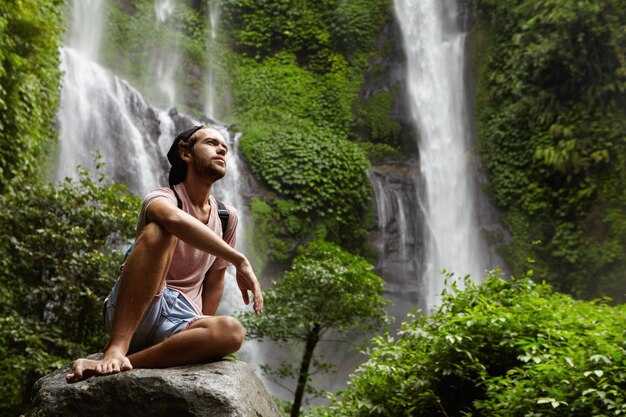порада: arrive before 9 am to enjoy cooler temperatures and clearer viewpoints on the Brazilian side. If you have arrived, head straight to the upper decks to catch the spray without long lines. Plan your route to maximize short walks between shaded spots and bring a light backpack with sunscreen and a microfiber towel.
Find your base: The belmond Hotel das Cataratas on the Brazilian side offers easy access to the park entry. If you lean toward budget options, frequent hostels around Foz do Iguaçu keep daily costs reasonable. michaela, an australian traveler, says a flexible plan and conversation with staff unlock quiet paths after rain. bring an amount for local taxis or shuttle buses, and reserve a couple of hours for a relaxed morning walk.
What to wear and pack: Wear sturdy shoes with grip for slippery stones. dont forget a lightweight rain jacket; the spray from the falls sticks to everything. Pack a compact poncho, bottled water, and a small power bank for photos. A daily plan helps you hit viewpoints in the best light, especially as temperatures rise.
Plan your route: Start at the main Brazilian circuit and work your way to the Garganta do Diabo overlook. Use the park shuttle to hop between trailheads, especially in peak heat. Look for wildlife, like toucans and coatis, along shaded stretches. A well-timed visit in the morning or late afternoon yields better lighting for photos.
Practical tips: Bring protection for cameras; the spray can fog lenses. dont rely on data connectivity in the park; download offline maps beforehand. The amount of walking is moderate but stairs add up; take breaks and hydrate. Consider a late-afternoon viewpoint, when temperatures drop again and mist creates rainbows.
Best Time to Visit the Brazilian Side for Garganta do Diabo Viewpoints
Plan your visit for May or September and start before 9 a.m. to catch Garganta do Diabo viewpoints on the Brazilian side with soft light and thinner crowds.
In these dry-season months, the wide catwalk stays dry, the air is comfortable, and visibility is best for photography. If you come in summer, be ready for higher humidity and occasional showers that heighten the mist and create dramatic portraits; the views remain powerful, especially in early morning light or late afternoon when the land and forest contrast most.
weve found that morning visits pay off: over the years, travelers have learned to optimize timing by starting early; weekdays are generally calmer; backpackers and local guests mix with day-trippers on weekends, but the quieter hours are still present. To simplify logistics, use rideshare from town to the park entrance, a reliable means to avoid parking hassles. On-site facilities provide a simple lunch option at the gate, but for a fuller meal you can purchase in town or at a nearby mall after your visit. wifi coverage is strongest near the main plaza; along the main catwalks it can be spotty, so download offline maps in advance. At the gate you obtain a map and can purchase tickets online to start smoothly. The Garganta route on the Brazilian side is wide and well-maintained, with viewpoints that place you between the spray and the forest land; some overlook on the opposite bank offer a different perspective if you plan a separate day trip to the Argentine side.
Timing and viewpoints
- Start early: aim for 7:00–9:00 a.m. to beat crowds and catch the best light.
- Prefer May or September for lower rainfall and comfortable temperatures, with strong water flow still present.
- Choose weekdays when possible; weekends draw backpackers and families, increasing crowding at key lookouts.
- Check the weather and park alerts the night before; morning mists can affect visibility if you start too late.
Practical planning

- Wear sturdy shoes for a wide, well-maintained path that remains mostly flat but can be slick after rain; plan for tiny spray droplets on skin and glasses.
- Pack light rain gear, sunscreen, and a small backpack; dorm-style hostels around town offer budget options if you’re traveling with a group.
- Purchase tickets online in advance to start your day smoothly; at the gate you can obtain a map and you’ll see coverage updates on-site.
- Use rideshare means to reach the entrance; it’s a common, cost-effective option for solo travelers and groups.
- Be mindful of wifi coverage: stay offline with maps if the signal is weak on the trails; download the route beforehand.
- Consider adding a second day to explore the Argentine side for a fuller variety of viewpoints between the two countries.
Getting There: From Foz do Iguaçu to the Brazilian Park Entrance
Book a private transfer or use a reliable taxi to reach the Brazilian Park Entrance quickly. From Foz do Iguaçu to the entrance, expect about 25–30 km of road, 30–45 minutes in light traffic; peak times can stretch it to 60 minutes. If you arrive via the IGU airport or other area airports, a pre-booked shuttle or taxi offers door-to-gate service, saving you stops and backtracking. Here’s a practical approach that keeps everyone on track.
Two solid ride options: private transfer or public bus
Option A: Private transfer. A driver waits in the arrivals hall at IGU or at your hotel and delivers you directly to the Park Entrance. Expect to pay around R$80–120 one way, depending on your hotel location and traffic; it’s better to pay a bit more for reliability, especially with kids or a lot of gear. If you’re traveling with others, the per-person cost drops and the space helps you pack everything you need. Passengers appreciate the convenience after travel, and the driver can stop for a quick photo along the road if you ask.
Option B: City bus. From downtown Foz, Bus 120 Cataratas runs roughly every 30–40 minutes and stops at the park gate. The ride takes about 60–75 minutes and costs around R$5–7. Board at the Terminal de Ônibus or at major urban stops; you’ll avoid parking hassles but share the ride with other passengers. If you missed the first bus, there are later departures–check the current timetable at your hotel or the terminal; plan to arrive early to beat the heat and crowds. Instead, if you’re on a tight budget, this is a better choice for the day.
There, crossing to the argentinean side is optional but can be a good complement in a full day. If you decide to cross, bring your passport and be prepared for customs checks; plan a separate entry and exit window, and note that afternoon temperatures can rise a few Fahrenheit degrees. If you want to explore ciudad neighborhoods on the other side, do it after you finish here and return for the Brazilian gates.
Practical packing and planning: pack light, leave bulky bags at the hotel if possible, and carry a small water bottle; the weather on the Brazilian side is sunny most days. In summer, temperatures often peak in the 80s or 90s Fahrenheit, so sunscreen, a hat, and a light jacket for cooler mornings help. The entry plaza is a short walk from the bus stop, but you’ll do more walking inside the park beyond the gate. Here, the shortest walk from the gate to the main outlooks takes about 15–25 minutes. If you’re touring with kids, pace yourself and add rests; everyone benefits from a relaxed rhythm. Create a simple itinerary list to guide your day, then review it at the bus stop to learn about current conditions and time windows, and leave some buffer for unexpected stops with others who share tips and plans.
Finally, a quick note to add to your plan: begin at the entrance, buy tickets, and consider the electric train for faster access to the most famous viewpoints on the Brazilian side. The vistas are amazing, and mornings offer softer light for photos. If you want a special day that blends park scenery with city culture, this route is worth the effort. The plan is straightforward, practical, and designed for smooth travel; by following these steps, you’ll avoid delays and enjoy the falls with less stress.
Ticketing, Parking, and Entrance Logistics for Garganta do Diabo
Purchase tickets online in advance and select an earlier time slot to make the visit easier and to avoid crowded queues during peak months.
Ticketing options on the official site include single-entry passes and combination experiences. Price varies by age and country of residence, with exchange rates available at checkout. The site accepts cards and cash, and the counter at the entrance can process exchanges for nearby networks if necessary.
Parking near the entrance is limited. Lot A sits closest to the Brazil-side entry, while Lot B is about a kilometre away along a walkable path. Expect hourly rates, with payment possible at the booth or via a mobile app. Plan for 1–2 hours if you want to explore both circuits and the lookout points without rushing.
Entrance logistics place you at a controlled gateway for Garganta do Diabo. Gates open early and close in the late afternoon; bring only essential belongings to speed checks, as staff conduct standard security inspections. Have your requirements ready–photo IDs, tickets, and any permitted tech–while keeping belongings compact to avoid intrusive lines. Use the main walkway and circuit route to reach the famous lookout without backtracking.
Local guidance from avid visitors adds value: Silva, a guide from Barroso, suggests starting at the lower circuit lookout to catch the best light, then following the walkways along the main circuit. The route is walkable for most guests, with a comfortable kilometre-scale stretch between lookouts. After the falls, many travelers enjoy a relaxed dinner nearby before departing for the airports or hotels in the country.
| Категорія | Рекомендація | Примітки |
| Ticketing | Book online; choose morning slot; print or save on phone | Price varies by country and age; exchange available at counter |
| Parking | Use Lot A near entry; Lot B is a short kilometre walk | Pay hourly; app or gate; plan 1–2 hours |
| Entrance | Arrive early; carry only essentials | Security checks are standard; lookouts along the walkway |
| Поради | Bring water, wear walkable shoes, consider a dinner stop after | Avid photographers will appreciate early light; Silva recommends route via lower circuit |
The Main Trail: Distances, Prime Viewpoints, and Walking Time to Devil’s Throat
Start at the entrance and walk directly toward Garganta do Diabo; this one-way segment conveniently sets you up for the final platform and definitely feels efficient for most visitors.
Головна стежка до «Горла диявола» простягається приблизно на 2 км в один бік, при комфортному темпі на відкритому повітрі це займе приблизно 40–50 хвилин ходьби. Якщо ви плануєте затриматися на кожному оглядовому майданчику та зробити багато фотографій, виділіть 60–90 хвилин на повний підхід до кінцевої платформи.
Головні точки зору та пішохідний проліт
Приблизно через 0,7–0,9 км перший оглядовий майданчик відкриває широкий вид на нижні каскади та бризки, які створюють веселки при яскравому світлі. Продовжуючи ще 0,5–0,6 км, ви потрапите на платформу посередині стежки з ширшою панорамою на річку та лісисті береги.
Фінальна платформа Garganta do Diabo знаходиться приблизно на позначці 2 км, забезпечуючи найвищий, найбільш захопливий вид на підковоподібний каскад зблизька. Це високий, драматичний момент, який усі фотографують, з бризками на вітрі та вражаючим масштабом, що робить решту шляху вартим того.
Уздовж маршруту ви знайдете місця для сидіння та затінені місця для відпочинку, що робить прогулянку комфортнішою для сімей та тих, хто пам’ятає про спеку чи сонце. Щодо потреб мобільності, зверніться до інформаційного центру щодо доступу до верхніх терас за допомогою ліфта; деякі ділянки пропонують доступ по пандусу або альтернативні маршрути до головної палуби.
Незалежно від того, чи відвідаєте ви вранці чи вдень, тінь і місця для сидіння допоможуть вам підтримувати стабільний темп. З оглядових майданчиків ви побачите, як річка широко розливається на північний захід і навколишні джунглі, де в спокійні години можна спостерігати за дикою природою. Зверніть увагу на знаки іспанською та португальською мовами, на яких вказані відстані, і тримайте під рукою карти для детального плану ваших конкретних зупинок. Якщо ви відчуваєте прилив енергії, кожен оглядовий майданчик стає активним відпочинком на природі, перетворюючи саму стежку на компактну екскурсію.
Цей план ви можете пристосувати до свого темпу та інтересів. Якщо ви зупиняєтесь у цьому районі, довколишні ресторани пропонують швидкі перекуси до або після прогулянки; якщо у вас обмаль часу, ви можете скоротити маршрут, повернувши назад після першого або другого оглядового майданчика, і все одно охопите основні моменти.
Що одягнути та що спакувати для прогулянок тропічним лісом
Почніть зі штанів або шортів, що швидко сохнуть, та дихаючої, водонепроникної куртки; взуйте міцне взуття із закритими носками та хорошим зчепленням. Якщо ви плануєте пересування велосипедом або коротку поїздку між місцями, виберіть взуття з надійною фіксацією та візьміть рукавички.
Багатошаровість допомагає: вологовідвідний базовий шар, легкий середній шар і компактна дощова куртка. Ваш вибір одягу залежить від прогнозу погоди та вашої стійкості до вологості; вранці прохолодніше, і температура може швидко підвищуватися на великій висоті. Дощ може прийти дуже швидко, тому будьте готові.
Що взяти з собою
Від входу візьміть із собою рюкзак на 8-12 літрів із сухим мішком для електроніки. Запакуйте пляшку з напоєм або систему гідратації; прагніть мати принаймні 1,5 літра на 60-90 хвилин ходьби.
Захист від сонця: капелюх, сонцезахисні окуляри, сонцезахисний крем. Захист від комах: репелент. Захист від дощу: пончо або легка дощова куртка, якщо ваш рюкзак не має накриття.
Водонепроникний чохол для телефону або камери; запасні батареї; енергетичний батончик.
Термальні джерела знаходяться неподалік, тому візьміть рушник, якщо є план відвідати термальні джерела після прогулянки.
Майте готівку в песо для прикордонних пунктів; більшість покупок у парку приймають картки, але деякі кіоски працюють лише з готівкою. Щодо проживання та харчування, поблизу є готелі та ресторани; сплануйте все відповідно.
Національні та міжнародні відвідувачі можуть замовити трансфер і таксі біля входу; години роботи залежать від сезону. Більшість кіл займають 60-90 хвилин; бувають дні з великою кількістю відвідувачів, тому залиште додаткові хвилини для фотографій і оглядових майданчиків.
Поради з фотографії: Зйомка водоспадів Іґуасу з бразильського боку
На світанку вирушайте в район порту, щоб насолодитися свіжим бризом і теплим світлом на платформі для стрибків; тримайте напоготові світлосильний об'єктив і часто протирайте фільтр від вологи, щоб зберегти чіткі краї туману. Розвивайте звички зйомки: перевіряйте світло кожні кілька хвилин і оглядайте сцену перед зйомкою, щоб не пропустити швидкоплинну веселку.
З бразильського боку огляд на стежках обмежений, тому заплануйте 60-90 хвилинний маршрут, щоб охопити основні оглядові майданчики та внутрішні стежки під пологом лісу. Перевірте оновлений графік роботи парку та відправлення, щоб узгодити свій розклад із більш тихими моментами; дата та погода впливають на відображення, і загальні умови можуть швидко змінюватися. Якщо ви поєднуєте поїздки до місій, ретельно координуйте, але залишайтеся гнучкими, щоб уникнути настирливих натовпів. Використовуйте це як основу для планування свого маршруту, щоб максимально збільшити сонячне світло на кожній перспективі.
У парку натовпи можуть заважати поблизу головних платформ; намагайтеся знімати відразу після вибуху бризок, а потім відійдіть у пишні околиці для інтимних кадрів поблизу води. Будьте уважні до дикої природи вздовж країв, зокрема до котів. Парковка зручна біля входу, але повертайтеся до того, як натовп шатлів досягне піку; ви знайдете на диво тихі куточки вздовж бічних стежок, і будете раді, що одягли зручне взуття, щоб захистити ноги.
Найкращий час та вигідні точки
Перше світло з’являється після світанку; з точки зору сальто ви зловите веселку, коли сонце піднімається. З деяких оглядових майданчиків ви побачите величезні перспективи водяної завіси, а потім перейдете вздовж дощатої набережної, щоб обрамити водоспади, коли бризки пронизують ліс. Для надзвичайно драматичних силуетів затримайтеся до пізнього ранку і знову пізно вдень, коли тіні тягнуться вздовж каскаду. Подумайте про другий прохід по внутрішньому колу, щоб зафіксувати водяні стрічки крізь дерева. Загалом, виберіть кілька ключових місць і використовуйте легкий штатив, щоб уникнути хитання на дощатій набережній, при цьому завжди залишайте місце для переслідування мінливих бризок.
Спорядження, налаштування та планування

Використовуйте ширококутний об'єктив (16-35 мм) для панорам і середній телеоб'єктив (70-200 мм) для зйомки великим планом водних поверхонь і туманних аур. Встановіть експозицію приблизно f/8–f/11 та ISO 100–200; для шовковистої води спробуйте 1–2 секунди зі стійким штативом або перейдіть на швидшу витримку, якщо вітер змінює бризки. Поляризатор допомагає зменшити відблиски у яскраві дні, а фільтр нейтральної щільності подовжує тривалість ваших довгих витримок. Знімайте у форматі RAW і використовуйте програми для картографування маршрутів, перевірки паркування та відстеження часових вікон і відправлень. Якщо ви зупинитеся поблизу, 2–3-годинне вікно підійде для спокійного темпу; для сімейних поїздок робіть короткі сегменти та передбачте можливість розкошування у розкішному готелі поблизу. Якщо ви поєднуєте подорожі до місій або комбінуєте поїздки, ви знайдете більше краєвидів і менше очікувань. Завершіть швидкою перевіркою: відійдіть назад, щоб оцінити масштаб і захистити обладнання від бризок.



Коментарі